The saga of Italian Torpedo Boats
Italy was not long to take advantage of the Whitehead torpedo, developed by its adversary on the other side of Adriatic, invented 1866 by Robert Whitehead from a rough design conceived by Giovanni Luppis of the Austro-Hungarian Navy in Fiume. The Regia Marina’s first capital ships to sport torpedo tubes were the Duilio class (1876), while masted cruisers like the Caracciolo (1869) had a 15 inches tube added in 1875, as Colombo, but Flavio Goia had two smaller 14-in tubes from the start, as Vespucci, but not the steel corvette Cristoforo Colombo (1894). Torpedo tubes wee not ssytematic though, neither gunboats nor despatch vessels built in the 1870-80s were torpedo armed.
The Italian Torpedo Cruiser fad (1876-90)
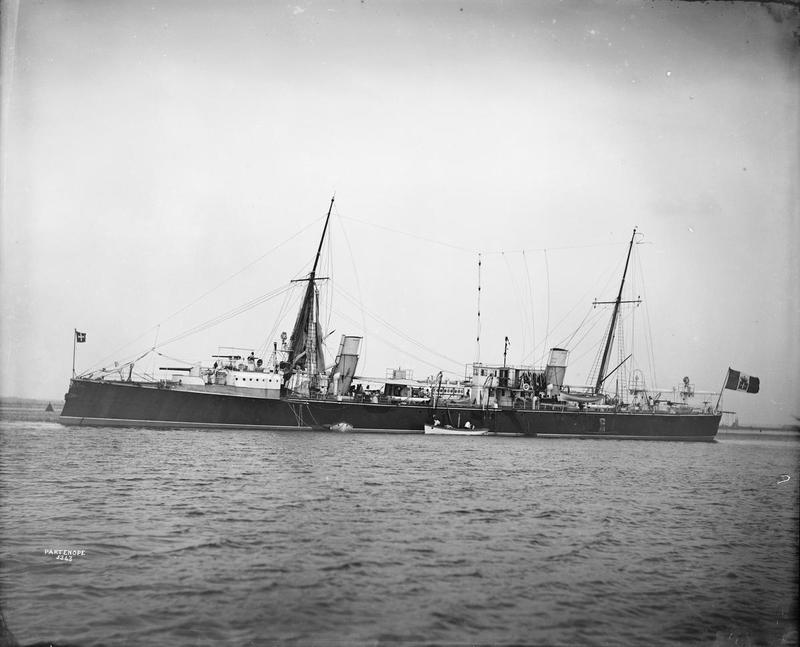
RN Partenope (1886)
Of course a dedicated vessel was soon built to integrate the new device, the infamous “Torpedo Cruisers”, somewhat failed ancestors of the destroyers. Pietro Micca was the first to have a single 16-in tube and two machine guns in 1876. This 500 ton vessel, only capable of 13 knots, was followed by Tripoli (1885), a much larger, faster 900 tons vessel armed with five 14-in tubes. The Regia Marina next ordered larger classes, such as the four Goito class (1887-89), the two small Folgore (1886) “torpediniere-avisos” designed by Brin, and the eight vessels of the 900 tons Partenope class (1889-93). Th next Agordat class protected cruisers were still armed with two 17.7 inches (450 mm) tubes, and twelve Ansaldo 3-in guns, a rather weak armament for 1,300 tons cruisers. But at this point like other navies, the Regia Marina abandoned the concept for larger torpedo boats, eventually destroyers, which started to appear in 1893.
The first Italian Torpedo Boats (1878-81)

Italian prototype spar torpedo boat (1877) from Thornycroft
Like Germany or Austria-Hungary, Italy lacked the experience with very small, fast boats and ordered its first torpedo boat to Thornycroft in 1878, owing its good relations with UK. Nibbio was therefore commissioned in 1881, rated as fourth class. She was followed by further prototypes or “samples” from UK, Avvoltio (1879), Sparviero (1881), both to Yarrow and Aquila (1881) to Thornycroft, leaving a two years gap to see technological advances and gain experience in dealing with the new vessels. What was intresting with these, was their propulsion system, which differed for each and allowed comparisons.
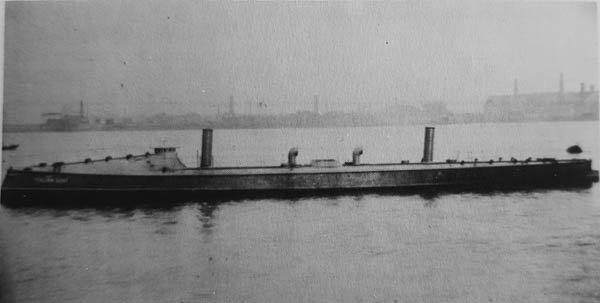
77Y, built in Venice
⚙ Compared Specifications |
|||
| Name | Dimensions/Displacement | Propulsion/speed | Armament |
| Nibbio (1878) | 24.38 x 3 x 1 m/25,5 tons | 1 shaft TER, 1 boiler 250 ihp/18kts | 2x 14 in TTs |
| Avvoltoio (1879) | 26.21 x 3.3 x 0.95 m/25 tons | 1 shaft VTE, 1 boiler 420 ihp/22.5 kts | 2x 14 in TTs |
| Sparviero class (1881) | 30.43 x 3.81 x 1.49/39,5 tons | 1 shaft VR, 1 boiler 620 ihp/22.5 kts | 2x 14 in TTs |
| Aquila (1881) | 29.18 x 3.28 x 1.47/34,5 tons | 1 shaft VDE, 1 boiler 475 ihp/20 kts | 2x 14 in TTs+ twin 25 mm |
All these vessels were originally intended as midget 4th class TBs, to be operated from capital ships used as “motherships”, and used as an active close defense, one of the concepts explored notably by Brin around the torpedo. They were all crewed with 10-11 men, and renamed: Nibbio became 1T (T standing for Thornycroft, not torpedo) in 1886, and was converted as a steam boat PE44 later, BU possibly in 1906. Avvoltoio became 2Y (for “yarrow”) in 1886 and was discarded in 1904. Sparviero and Falco became 22 and then 25Y in 1886, also discarded in 1904. The paved the way for the “stars” (stella) series of the 1880s-90s, all small 4th or even 5th rank vessels to international standards.
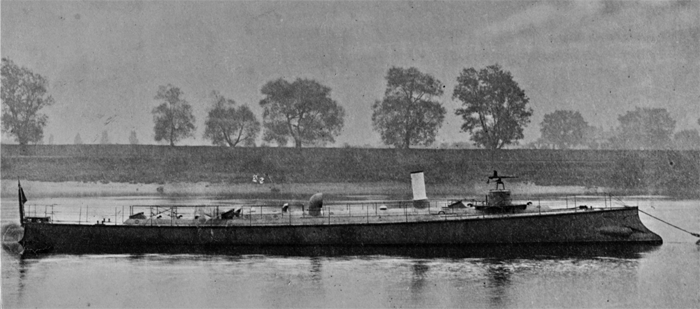
Gabbiano.
The first Italian-built Torpedo Boats (1882)

Mosca class
Note: These were all discarded in 1914. They could be seen more in detail in a dedicated post related to the 1890 Regia Marina.
The very first prototype was ordered to Orlando Leghorn yard, designed by Engineer, director Luigi Borghi, still 4th class owing to her 30 tons displacement; Choice was made of a single shaft vessel propeller by a triple expansion, reciprocating (TER) engine fed by a single locomotive boiler, rated at 250 ihp for 18 knots. Armament stays the two single 14-inch tubes (356 mm), one fixed, prow, one traversing, amidship. Classed as fourth class TB, primary interest for the boat was to be operated from the Battleship Caio Duilio, in total fighting trim. Although launched in 1882, trials and fixes had he commissioned only in 1885 and later renamed 11T the next year. Mostly experimental, she was discarded in 1904.
Next a serie of Aldebaran and Euterpe class (plus the Mosca) were built in several groups ordered in various yards at the same time, Thornycroft, Odero, Orlando, Pattison, and Guppy. They shared similar caracteristics to the previous vessels, all 3rd class at 38.5 tons (Aldebaran 1,2,3,4, 5th groups) and lighter 4th class at 13.5 tons for the Euterpe class (2 groups) and the relatively similar Mosca class (1883)
 Aldebaran class TBs (1882-87)
Aldebaran class TBs (1882-87)
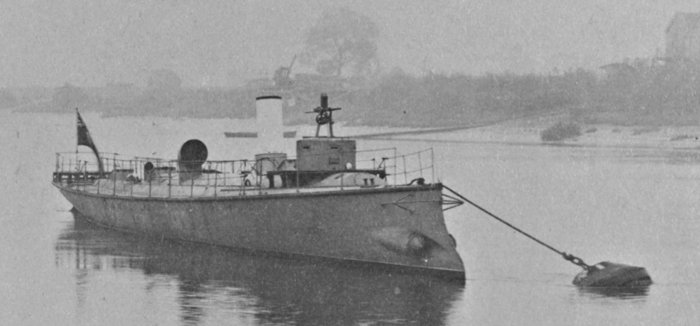
Aldebaran class
Aldebaran, Antares, Andromeda, Centauro, Dragone, Pegaso, Perseo, Sagittario, Sirio, Orione, Canopo (1st gpe), Arturo, Spica, Cigno, 50T/51T (2nd gpe), Vega, Rigel, Castore, Polluce (3rd gpe), Procione, Lira, Idra, Regolo, 54T, 55T (4th gpe), Acquario, Cassiopea (5th gpe).
In all, 34 boats of this class were built, delivered on similar specs, ordereded in 1882-84 from Thornycroft (10 boats), Odero Sestri (4 boats), Orlando (6 boats), Pattison (6 boats) and Guppy in Napoli (2 boats launched in 1885). The one inch or 25mm/41 twin-barreled heavy machine gun, Nordenfelt type. No reloads for the 350 mm torpedo tubes. Turtleback hull, ram type bow with the two forward, fixed tubes. No mast but a small command post whith the stering wheel inside, a projector, a small service boat. Apart 39T lost in a collision, they were all discarded in 1907-1914.
⚙ Aldebaran class specifications |
|
| Dimensions | 30.58 x 3.58 x 1.67 m (100 ft x 11ft 9in x 5ft 6in) |
| Displacement | 38-1/2 tons standard |
| Propulsion | 1 shaft VDE, 1 loco boiler, 430-455 ihp. |
| Top Speed | 21 knots (xx km/h) |
| Armament | 2x 25mm, 14-in TTs (356mm) |
| Crew | 10-11 |
 Euterpe class TBs (1885)
Euterpe class TBs (1885)
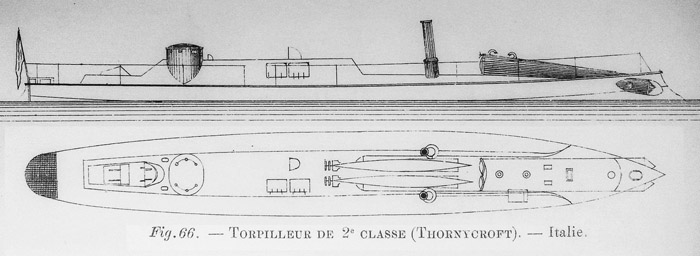
Euterpe class
Euterpe, Talia, Erato, Melpomene, Tersicore, Polimnia, Urania, Calliope (1st) Lucciola, Formica, Cicala, Locusta, Grillo, Zanzara (2nd)
Two groups, eight boats total coming from Thornycroft, Cheeswick in 1883 based on the same 4th class design. They were discarded in 1896-1904.
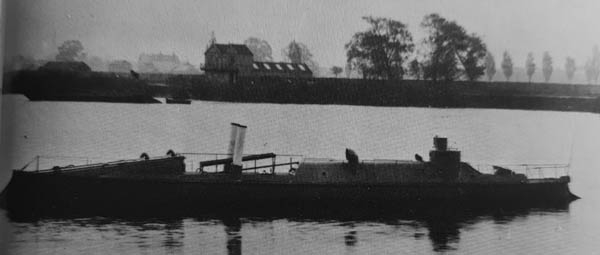
Euterpe class

Euterpe class
⚙ Euterpe class specifications |
|
| Dimensions | 30.58 x 3.58 x 1.67 m (100 ft x 11ft 9in x 5ft 6in) |
| Displacement | 38-1/2 tons standard |
| Propulsion | 1 shaft VDE, 1 loco boiler, 430-455 ihp. |
| Top Speed | 21 knots (xx km/h) |
| Armament | 2x 25mm, 14-in TTs (356mm) |
| Crew | 10-11 |
 Mosca class TBs (1885)
Mosca class TBs (1885)

Mosca class
Mosca, Ape, Vespa, Farfalla
These Thornycroft 4th class TBs built in 1883 were renamed 12-15T in 1886 (and thus are also known as 12T class). Mosca was later transferred to customs service, the others were discarded in 1898.
⚙ Mosca class specifications |
|
| Dimensions | 20.12 x 2.44 x 1.34 m (66 ft x 8ft x 4ft 5in) |
| Displacement | 16 tons standard |
| Propulsion | 1 shaft VR, 1 loco boiler, 250 ihp. |
| Top Speed | 20 knots (xx km/h) |
| Armament | 2x 14-in TTs (356mm) |
| Crew | 10 |
 “YA” class TBs (1894-95)
“YA” class TBs (1894-95)
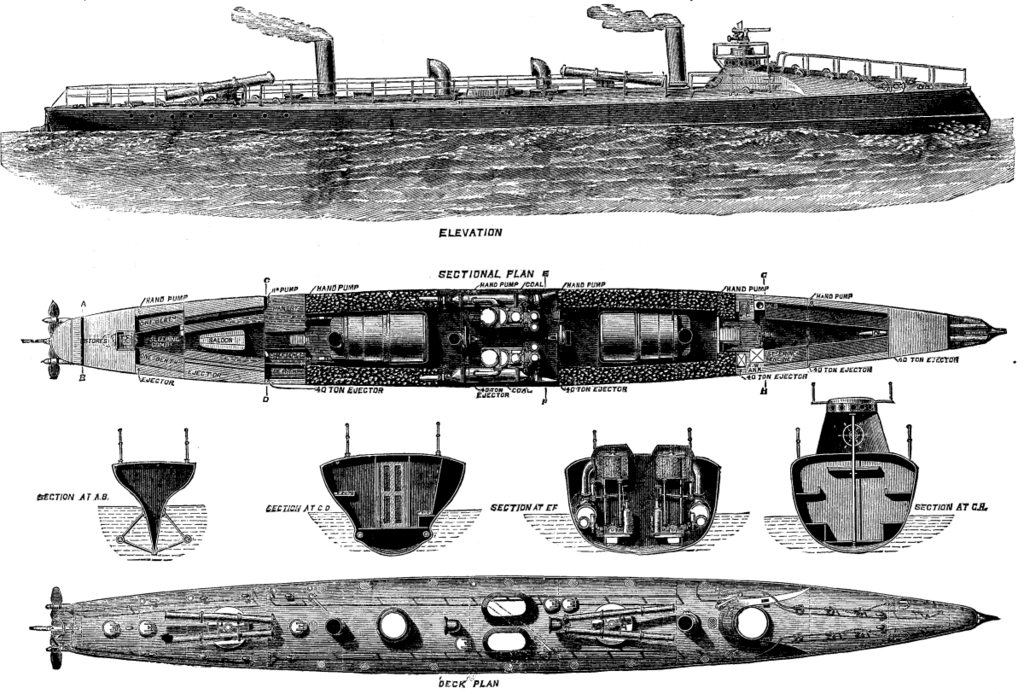
Torpedo Boat 76YA
Four second class TBs built in Yarrow for the first, 76-77YA and Venice NyD, for 78-79YA. Development and construction was slowed down in Italy by budgetary problems. There was a 4 kts difference between them on trials. Overall they were considered however very successful. In 1898 77YA was equipped with watertube boilers. All four were discarded in 1907-1910.
⚙ ’76YA’ specifications |
|
| Dimensions | 41.18 x 4.27 x 1.54 m (135 ft x 14ft x 5ft 1in) |
| Displacement | 108-1/2 tons standard |
| Propulsion | 2 shaft VDE, 2 loco boilers, 1600-1640 ihp. |
| Top Speed | 22-26 knots (xx km/h) |
| Armament | 1x 37/25, 1x 37/20mm, 3-4x 14-in TTs (356mm) |
| Crew | 10-11 |
 “S” class TBs (1887-93)
“S” class TBs (1887-93)
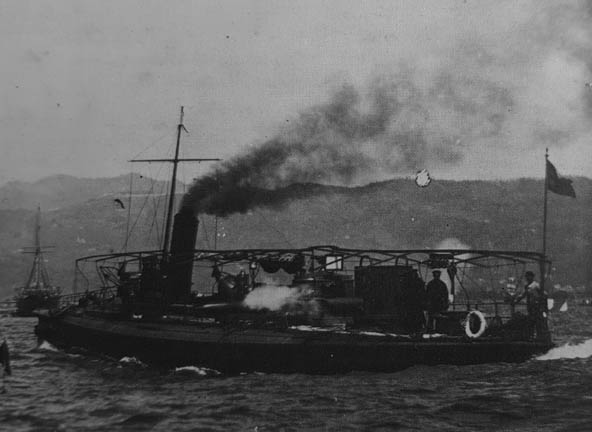
S67 (Guppy) 1898
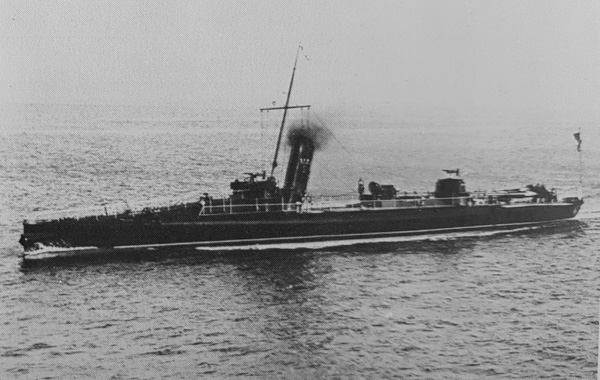
144S (Ansaldo) 1893
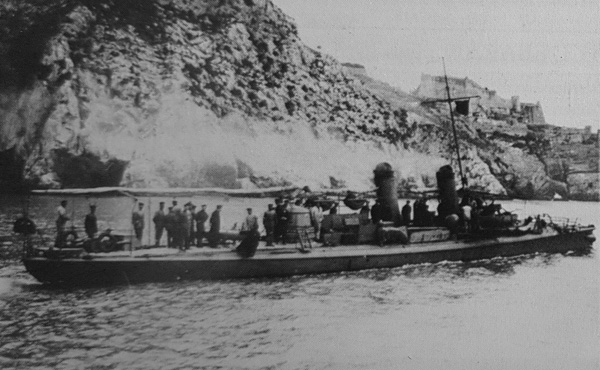
75S (Odero). All, A. Fracaroli coll.
Italy in 1886 started to order Schichau boats, and this went on until 1888, with the last boats delivered in 1895 for a total of around 60 vessels. They made the bulk of the 2nd class Italian TB force at the start of the Italian-Turkish war. The first 19 were all ordered in Germany, at Schichau, Stettin, the great specialist of the time. The rest were ordered respectively in Odero, Cravero, Guppy, Pattison and Ansaldo Yards in Italy under licence to gain time.
Schichau Order 1886-87:
19 boats, Lead vessel 56S later renamed 81S. Some had their TT fixed in the bow, other had one fixed, one trainable aft. 104S was used for fuel oil experiments under the direction of Eng. Vittorio Cuniberti, and successful. The boats were all converted to oil later, and watertube boilers adopted. This traduced in S82 by the addition of a second funnel. S106 was used to test wireless telegraphy for TBs. In November 1886, S56 sank in the bay of Biscay after colliding with 57S. The same month, S105 foundered during a gale in the Piombino Channel October 1890 and the rest were discarded in 1907-1914 with the esception of 102S which served in WWI as a pilot boat, discarded 1923.
Odero boats (1887-95):
26 boats converted to oil fuel and in 1898, 75S and 95S received watertube boilers and second funnel. 137S was wrecked in November 1906 off Favignana. All the rest wre discarded in 1904-14 except 128S that took part in WWI (discarded 1920), 129S sunk as target and 105S converted as minesweeper.
Cravero Boats (1887-94):
12 boats. 68S was active as pilot in WWI, 117S was lost off Brindisi in 1894. All discarded 1905-1914.
Guppy Boats (1888):
Just two boats built in Naples, 66 and 67S. They tested new types of trainable TTs and were discarded in 1905.
Pattison Boats (1888-94):
Sixteen built with an output of 683-1082 ihp. Three converted later to fuel oil. 113S also had a Belluzo turbine. 114S tested wireless telegaphy. 115S was fitted witn a MAN diesel engine. 134S received two Normand small watertube boilers. All but five discarded 1913.
Ansaldo Boats (1888-94):
Eighteen boats, same as above but 728-1079 ihp output. More than half of these were converted to fuel oil in 1896-97, and all were discarded in 1907 to 1915. 87S was the sold lost due to collision in La Spezia, 1894.

⚙ ‘S’ class specifications (Original) |
|
| Dimensions | 39-39.84 x 4.8 x 2 m (128-130 ft x 16ft 6ft 2in) |
| Displacement | 78 tons standard |
| Propulsion | 1 shaft VDE, 1 loco boiler, 902-1080 ihp. |
| Top Speed | 21-22 knots (xx km/h) |
| Armament | 2x 37mm, 2x 14-in TTs (356mm) |
| Crew | 17 |
 Aquila class TBs (1888)
Aquila class TBs (1888)
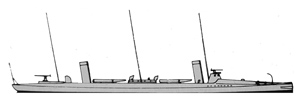
Aquila, Sparviero, Falco, Nibbio, Avvoltoio
Ordered in 1887 and built in 1888 these were large 1st class TBs built in Schichau, rigged as 3-mast schooners. In 1897 their armament comprised two 37mm/25, three TTs. They were discarded in 1912-14.
⚙ Aquila class specifications |
|
| Dimensions | 47.61 x 5.1 x 2.2 m (156 ft x 17ft x 7ft 2in) |
| Displacement | 137 tons standard |
| Propulsion | 2 shaft VDE, 2 loco boiler, 2180 ihp. |
| Top Speed | 24 knots (xx km/h) |
| Armament | 2x 37mm, 3x 14-in TTs (1 trainable) |
Technical aspects:


Ariete (Greenwhich Museum)
Italian WWI torpedoes
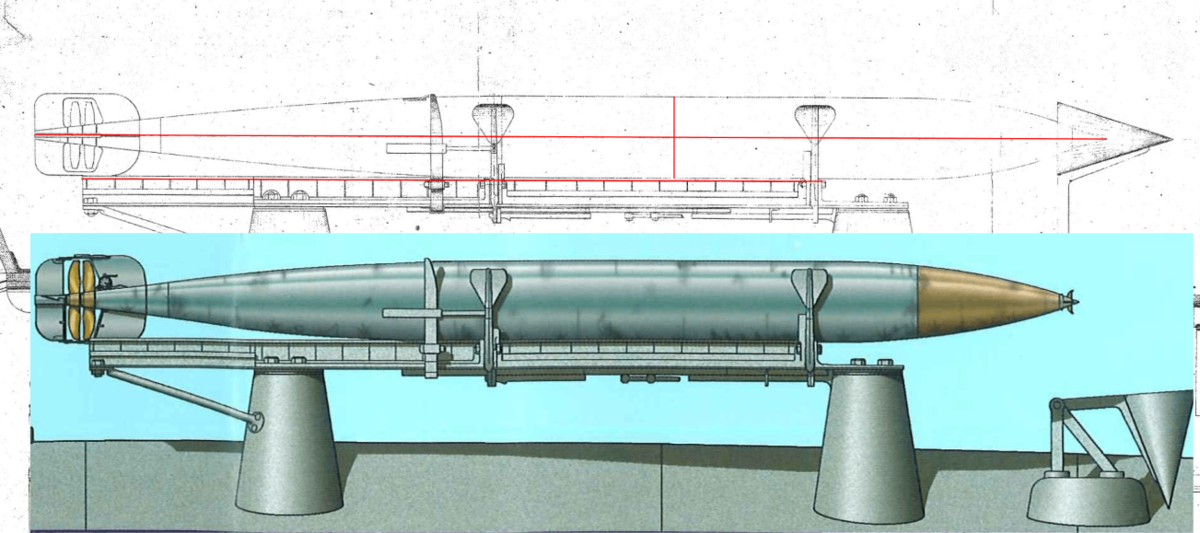
Comparison between the original drawing of the time (1895) and the dust jacket by V.M.Gay from the text of the Italian submarines and underwater assault vehicles by Turrini-Miozzi-Minuto – USMM 2010
Torpedo Models
There was a single manufacturer for Italian torpedoes at the origin, and until the great war broke out: Silurificio Whitehead of Fiume, the world’s oldest torpedo manufacturer, founded in 1860. It provided the standard types in use with Italian built and purchased German or British Thornycroft vessels:
-Spar Torpedo: According to Thornycroft designs, early 1877 proposals comprised a spar-torpedo vessel, however it seems regular torpedoes were favored early on.
-12 inches torpedo (305 mm) – Basically the Fiume Whitehead/Luppis model.
-14 inches torpedoes (356 mm) – Shared by all Italian TBs until 1910.
-17.7 inches torpedoes (450 mm) – All TBs from Schichau’s Sirio (1905). Strangely, Gabbiano (1907) went back to the 14-in caliber.
-21 inches torpedoes (533 mm) – None. They were introduced -(as for destroyers, even the 1923 Curtatone class still had 17.7 in types) in the mid-1920s and Sella class Destroyers (Even larger lead ships like the Poerio, Aquila, Mirabello, Leone, still had 45 cm tubes). The only exception was Cesare Rossarol, ex-B97 acquired in 1920, which had 500 mm tubes and German models.
-The Luppis torpedo (1875) was used in the Italian Navy as a single-propeller and compressed air (stroke 150 m), 27 kg. gun cotton warhead.
-The first modern mass-produced model was the siluranti A 34/356 W, built in Fiume by Whitehead in 1882. It was innovative by its use of two counter-rotating propellers, which stabilized it. This 356 mm (15 in) model had also a larger wahread of 34 kg. also gun cotton. Its air tank worked at 70 atmospheres, for a top speed of 22 knots over 400 m.
-The Siluranti B20 built in Berlin in 1884 by Schwarzkopff in bronze was also used by the Schichau models. Its tank worked at 90 atmospheres for 22 knots over 400 m and 20 kg warhead.
-The Siluranti B57 by Schwarzkopff and Rijeka (1888) had a tank at 90 atmospheres and 27 knots over 400 or 22 over 800 m and 57 kg. TNT wahread. It was the first with two settings.
-During WWI, a type A100/450 was recovered by the Austro-Hungarian Navy from the submersible Pullino grounded in July 1916. The Italians on their size recovered torpedoes carried by the Austro-Hungarian U12 that sank near Venice in 1915.
-The A140/450 resulting from it, built by Silurificio Italia after 1920: It was capable of 29-32 knots on the 6,000-4,000 m settings and had a 1140 Kgs TNT warhead of 140 kg of TNT, and air tank loaded to 170 atmospheres.
Prewar torpedo developments

Alongside the development or propeller, oxygen tank, warhead and body, progresses were made in locks, fuses, gyroscopes and when Italy entered the war more torpedo stocks were needed, not only the Silurificio Italiano was established in Baia, but a true R&D facility was created to try to improve speed, range, destructive capacity and accuracy. Tanks made in iron sheet were replaced by steel appeared and gun cotton by TNT in 1910 already. Its high stability and ease of processing were greatly appreciated.
In 1914 the Whitehead torpedo factory introduced an universal pendulum-type lock-device to determine the burst timing upon impact. It ensured operation at any angle of impact essentially. The 1877 Brotherood engine led way to the 1879 Brotherood-Whitehead using no longer a single central distribution valve but three cylindrical valves. In 1909, it’s speed, not warhread needs that led to a 533 mm (21-in) diameter, leading to the first two-cylinder sub-horizontal engine.
The adoption of swollen warheadswent back to 1896, preferred over refined ones thanks to higher speeds. The 1895 torpedo guide (by engineer Ludovico Obry) was purchased by Whitehead Silurificio in 1897, enabling automatic adjustment on italian torpedoes. This avoided lateral oscillations often causes of launch failure. Vertical fins were eliminated, notably as they increased friction in motion and if 1876 356 mm bodies prevailed, the need of a greater range and heavier payloads conducted Whitehead in 1889 to propose its 450 mm (17.7 in) and winning a competition in 1909 with a 533 mm.
WWI torpedo developments
At the beginning WWI, Silurificio di Fiume worked exclusively for the Central Empires, cuttinf its supplies to Italy as soon it declared war in May 1915. Following this, production in Fiume was transferred to St. Polten near Vienna, safe from Italian shellings. Only launching range remained in Fiume. These fears turned out to be well founded as on 2 August 1916 the whole area between Plase and Cantrida was shelled by the Regia Marina.
The factory produced some 1,780 450mm torpedoes, 64 torpedo launchers and 94 compressors at Rijeka shareholders approved bankruptcy of the company in 1918 and production as well as R&D was relaunched after Fiume went to Italy (Treaty of Rome, 27/1/1924) and Eng. Giuseppe Orlando became President. Inn 1928, it acquired full property as “Silurificio Whitehead di Fiume S. A.”.
The Rijeka factory was modernized in 1924, having 230 employees and producing 1,000 torpedoes in 1932. A launch & testing station was created in 1935, including to test airplane launches. But this is a story for the development of WW2 Italian Torpedo Boats.
Armament specifics and design
Cannone da 76/40
Guns-wise, artillery was intended purely as a meant of close defence, and grew in size and capabilities over the years, and larger designs. The initial 1878 experimental types were only armed with their Torpedoes, but Aquila (1881) was the first to receive a twin 25 mm Nordenfelt rapid fire Heavy “machine gun”, mounted on the kiosk.
The larger “YA”, large twin-screws Yarrow boats were armed with a more consistent battery, of a single 37 mm/25 and another of 37mm/20 guns. The first was mounted on the raised platform behind the forward turtleback. The numerous “Schichau” boats all had also two 37 mm, generally mounted for and aft. Prototypes of prewar series, like Condore and Pellicano, had two 37mm/25 H lungo QF guns.
 The Schichau-built Sirio class (1905) inaugurated a battery of three Hotchkiss (presumably) 47 mm/40 guns, far more potent than on previous vessels. The sraight bow Pegaso class and its sub-groups varied, the base ships having two 57 mm and one 47 mm, but they were rearmd as WW1 broke out with a more potent 76 mm/40 for some and/or 13.2 mm Breda heavy machine gun for AA defense. The clipper-bow Orione class (1906) had two 47 mm guns only, replaced in WWI also by two 76 mm.
The Schichau-built Sirio class (1905) inaugurated a battery of three Hotchkiss (presumably) 47 mm/40 guns, far more potent than on previous vessels. The sraight bow Pegaso class and its sub-groups varied, the base ships having two 57 mm and one 47 mm, but they were rearmd as WW1 broke out with a more potent 76 mm/40 for some and/or 13.2 mm Breda heavy machine gun for AA defense. The clipper-bow Orione class (1906) had two 47 mm guns only, replaced in WWI also by two 76 mm.
The “PN” series, all three, built before and during WWI started wioth a single Ansaldo 57mm/43 Modello 1883, but were all armed with this new standard gun, the 76/40 Mod. 1916 R.M. and its precedessor. It was a derivative, licence built of the QF 12 pounder 12 cwt, Armstrong 76/40 Model 1897. The Ansaldo 75mm/30 A1914 became a permanent fixture of the 40PN and 70OLT (Series II, III). This gun had an elevation allowing AA defense as well.
37 mm twin barrel
Likely the Nordenfelt type.
37 mm Hotchkiss
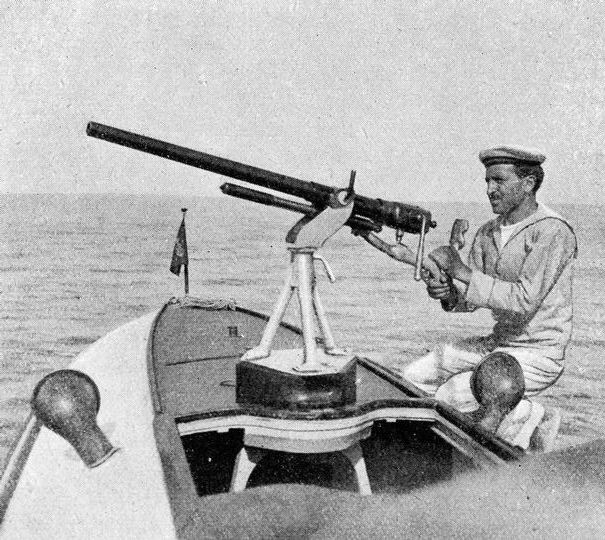
Hotchkiss 37 mm QF gun on a MAS in WWI
Standard 3-pdr Hotchkiss type
47 mm
Standard 6-pdr Hotchkiss type
57 mm
Likely the Vickers QF 12-pounder 12 cwt naval gun
Ansaldo 76mm/40 M1916
This gun fired the HE – 14.3 lbs. (6.5 kg) or 13.3 lbs. (6.0 kg) shell in AA configuration in italian service. It weight 1,676 kg, for 3,139 m in lenght, exact caliber 76,2 mm, single cartridge 6,016-6,820 kg, 12-15 rpm at 690 m/s. Elevation reached -5°/+75° for a maximal range of 5,500 m, up to 6 000 m.
Ansalso 76mm/30 M1915
The 510 kg (1,120 lb) pivot gun, 3.13 m (10 ft 3 in) long, needed a crew of 7. It fired a Fixed QF 76.2 x 420mm R shell 5.6–6.5 kg (12–14 lb). The mount had a -6° to +81° elevation, and rate of fire of 12-15 rpm, Muzzle velocity of 680 m/s (2,200 ft/s) and effective firing range of 10.7 km (6.6 mi) at +40°, 5.8 km (19,000 ft) at +70° and an AA ceiling of 4.8 km (16,000 ft).
Machinery of Italian Torpedo Boats
After the initial orders to Thornycroft in 1877-78, which allowed Italian teams to compare designs of various powerplants: TER (Triple expansion, Reciprocating), but also VTE (Verticle triple expansion), VR (Vertical Reciprocating), and VDE (Vertical, Double Expansion). The latter appeared as the most efficient and was kept for the next orders from Great Britain. Coal remained the order of the day, and was mostly stored in the sides of the hull, offering some protection.
The first Italian built vessels like the Mosca class were provided however with a triple expansion, reciprocating (TER) engine, fed by a single locomotive boiler (which was standard at the time) and reached 18 knots. Hardly an impressive speed, but quite common in the early 1880s. The large Aldebaran class TBs went back to the VDE, which became the great standard. Performanes differed a bit between yards. For the first time, 21 knots became the new standard speed. In the 1880s, most cruisers and battleships hardly reached 16-18 kts. For the first time, TBs could capitalize on their superior speed for hit-and-run attacks, compounded by longer-range torpedoes.
All these vessels had a single shafts, and lacked in agility, until the Regia Marina ordered the “YA” class to Yarrow, which introduced for the first time twin shafts and propellers, also leading to carry two VDE engines fed by two loco boilers. Thanks to this, they reached 26 knots on trials. In 1898, 77YA, built in Venice and 4 knots slower than her sister-ship, tested a small watertube boilers, far more efficient than the old loco boilers, soon reaching the same speed as her sister.
Next, Italy turned to Germany after a shifting in political alliaces, and order around 60 Schichau design boats which formed the 1890s generation, delivered from 1887 to 1895. They were all close to the first serie built in Schichau, near-copies, with the same single shaft and Schichau VTE engine plus the always dependable loco boiler. They still managed to reach 21-22 knots.
The 1st class “YA” seemingly lacked an inheritance. That is, until the Aquila class showed up. These Italian-built vessels also order from Schichau were very different, two-funnels vessel with two shafts. The staged loco boilers and VDE along the lenght of the ship and separate compartment allowed one to be flooded while preserving the other. Only four of these 1st class, 24 kts vessels were built, but they definitively cemented the admiralty’s interest for larger twin-shaft TBs.
In 1900, RN Condore was a single prototype, inspired by Schichau designs but built in Ansaldo, resembling the former aquila. Two shafts, two VTE engines this time, and three Yarrow small tubes boilers made her the most modern, powerful and fastest in the fleet: She reached 26 knots and had a 2000 nuatical miles radius of action. Still, like all the others, she ran on Coal.
Another interesting experimental boat was RN Pellicano, built in Odero at about the same time. She tested a different arrangement, with two shafts VTE also, but fed by three Blechynden boilers, for a total of 2,740 ihp. She only reached 21 knots for a design speed of 25.7 kts and a disappointment; This helped the admiralty to settle on the Condore design for the powerplant.
The Sirio class of 1905 were Schichau-built two shafts boats capable of 25 kts, which confirmed choices made in machinery arrangements. To continue comparisons, the admiralty next ordered to Shichau rival, Thornycroft, the first four boats of the standardized “Pegaso” class. They all settled on the same arrangement and top speed, two VTE, two Thornycroft boilers, and 25 knots. It should be precised that all these boats had ram-like “wave-piercing” bows.
RN Gabbiano was a 1906 experimental boat, testing an unorthodox assembly, two shafts propelled by two German Schichau triple Expansion engines, fed by two French Normand Watertube boilers, which were all the rage at that time (Condore also adopted them after conversion, oil-burning). However, despite an output of 2.190 hp, she only reached 22 knots and was not considered a successful design.
Also of note, she burn oil, not coal. Indeed, 104S in the 1880s was already was modified to burn fuel oil, under the direction of Eng. Vittorio Cuniberti, which saw its potential. This was a success, but without follow-up as for the Navy to adopt fuel oil as a standard the transition took about ten more years. Conversion were made for many boats in the late 1890s though. Two Pegaso class vessels were also given oil bruners from the start.
And after a long “vacancy” came the 1911 new standard serie of the PN (PN I, II and III) mass-produced during WWI. For all these, oil-burning Thornycroft Boilers were standard coupled with two VTE engines of local construction. Two of these were even testing turbines, a bit late compared to other navies. 31AS and 32AS were indeed equipped with three Parsons or two Bergmann steam turbines respectively; They were not overly satisfactory.
With their classic VTEs, all three PN series could sustain 27 knots, which was still way below the performance sub-standard compared to British Torpedo boats for example, capable in the 1890s of 30-33 knots. But they were in line with German Torpedoboote speeds, which reached 28 kts in 1904 however. The roughly comparable A-I types (1915) were much slower at 20 kts, 25 for the following A-II series and 26-28 for the A-III series. They were still much slower than the blasting fast French TBs of the 1890s like the 29 knots Cyclone class, and more so the Mistral class (36 knots) of 1901, last French TBs, before efforts were concentrated on destroyers.
General Assessment: Adriatic Operations
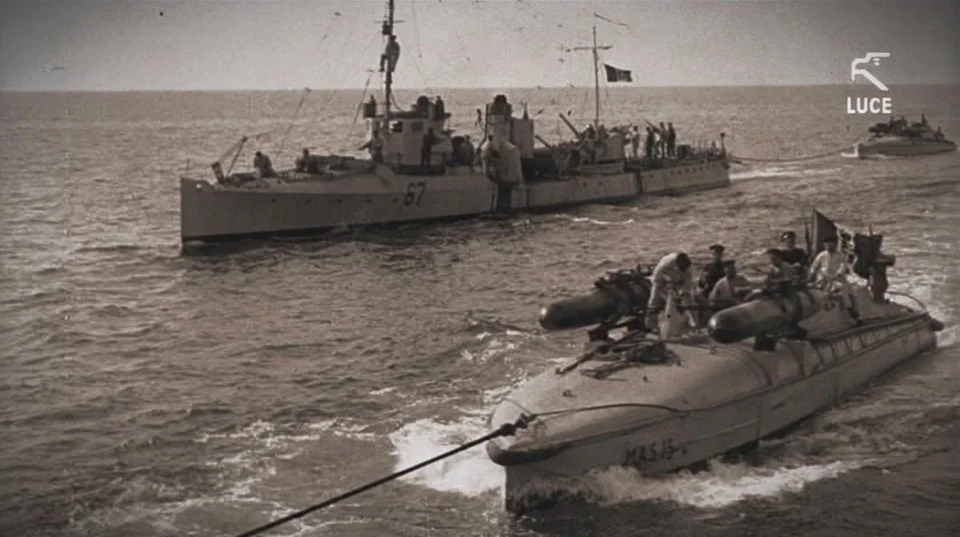
67PN training with MAS 15 in 1918 (luce video extract)
All torpeod boats could not be available for immediate operations in the Adriatic as many were also affected to local defence flotillas on the west coast (Thyrrenian sea) and Sicily, as well as Sardinia in 1915. Gradually, many were transferred to the Adriatic where their shallow draft made them more risky than major warships, such as cruisers and battleships, the latter being also subjected to submarine and Austro-Hungarian TBs attacks.
How the Italian TBs compared to Austro-Hungarian TBs ?
First off, the Austro-Hungarians started WWI with no less than seventy-nine torpedo boats, compared to italy’s 59 (80 with antiquated models), but 26 more would join the fray in 1915-1918.
Individually, the bulk of Italy’s first line TBs, making the main squadrons deployed in the Adriatic, comprised the thirty-seven Boats of the PN serie I (partly based in the southern base of Tarento), plus those of the Serie II later. The Sirio (6), Condore, Pelicano, Gabbiano, Orione and older vessels were mostly kept in the western coastal defense area. In venice, Vice-admiral Aristide Garelli, had under his command three battleships, three cruisers, the 3rd and 4rd destroyer (Cacciatorpediniere) squadrons, and the:
-5th Torpediniere (TP) Sq. (Procione, Climene, Pegaso, Pallade, Calipso)
-6th Sq. T.P. (19 OS-24 OS)
-9th Sq. T.P. (13 OS-19 OS)
-10th Sq. T.P. (1 PN-6 PN)
-11th Sq, T.P. (7 PN-12 PN)
This made just 25 TBs to cover the while northern Adriatic front.
The main opponents of the PN series were the 262 tonnes Tb-74 T class (1913) and the 244 tonnes Tb-82 F class (1914) as the 250 tonnes Tb-98 M class. The first two reached 28 knots and the last 29.5 knots, a bit faster that Italian boats. Armament-wise, the early TB-74T only had a twin TT bank, same caliber and essentually same torpedo type as used by the Italians. The Tb-82 F and Tb-98 M however were better armed, with a more versatile pair of 450 mm TTs. This was a relatively even match, but with a slight advantage for the Austro-Hungarians.
Admiral Paolo Thon di Revel in 1915 decided to switch its initial fleet in being operations, to “guerriglia marittima” (naval guerrilla). Battleships and cruisers (but the fastest) were to remain in the south to reinforce the Adriatic blockade. Light forces (including torpedo boats), screen with aviation, would launch naval attrition operations, in order to weaken the enemy fleet. France and Britain reinforced the Otranto blockade fleet, signing a convention on 10 May 1915. They too, would operate numerous destroyers in the area.
On 3 November 1918, Italy lost six torpedo boats in all, not a heavy price over the total deployed. Losse of destroyers in comparison were twice higher (8). It should be noted that as MAS squadrons became more consistent, Torpedo Boats were gradually sidelined. The average MAS in 1916 indeed had two of the same torpedoes, 30 kts, and presented a much smaller target. They were also way cheaper to built, to operate and maintain, and to add insult to injury, revendicated probably the biggest success of the Regia Marina in this theater of Operation, the sinking of Szent István. Italian TBs on the other hand never were credited with such major loss, or any of importance.
Italian prewar Torpedo Boats
 Condore (1900)
Condore (1900)

Condore was a prototype of 1st class TB built in Ansaldo, Genova from 1898. Launched in 17.9.1898 and commissioned in June 1900 she still was inspired by Schichau type boats with a wide rear section and general pear or almond shape of the hull. Two funnels far apart, its boilers were replaced by 2 Normand oil-burning after sea trials.
She displaced 138 tons, for 47.0 pp 48.0 oa x 5.55 x 1.36m, propelled by two shafts VTE fed by 3 Yarrow boilers for an output of 2,370 shp, and 26 kts as designed. She carried 42 tons of coal for 2000(12) nm radius of action.
Armament comprised two 37mm/25 H lungo QF guns and two single 350mm TT (15 in). Crew was 31. She fought in WWI and was discarded in 1920.
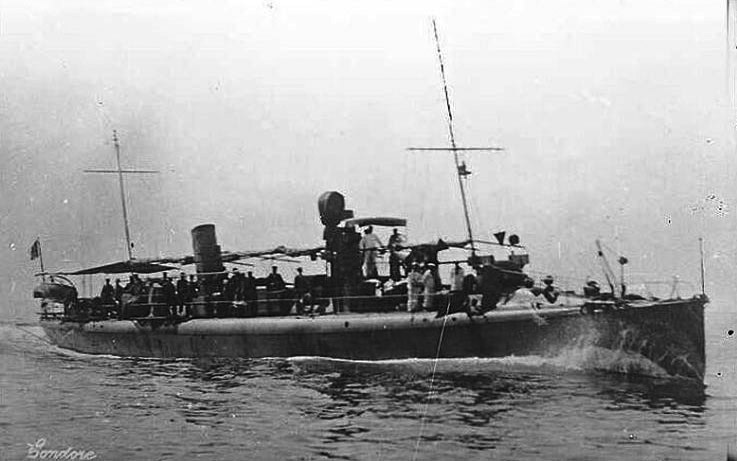
 RN Pellicano (1899)
RN Pellicano (1899)
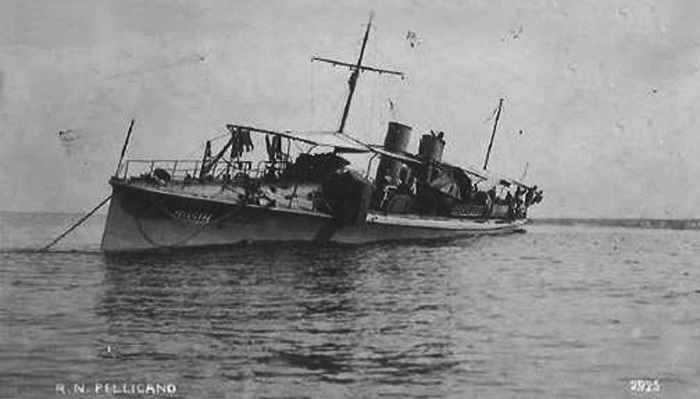
Pellicano anchored and listing. SRC
The single experimental first class Torpedo Boat was ordered to Odero, Sestri Ponente, laid down on 7/1896, launched 7.4.1899, completed 12/1900. She was a good sea boat, but her machinery was unreliable, and she never reached her planned designed speed of 25.7kts (very far from it in fact). Her armament was also weak for her size. The design was not followed through. Photo and specs on naviearmatori.net
⚙ RN Pelicano specifications |
|
| Dimensions/Displacement | 47.7/48.7 m oa x 5.74 x 1.53 m (), 148 tons standard, 181 tons FL |
| Propulsion/speed | 2 shafts VTE, 3 Blechynden boilers 2,740 ihp, 21 kts |
| Armament | 2x 15-in TTs (350mm), 2x 37mm/25 H Lungo type guns |
 Sirio class TBs (1905)
Sirio class TBs (1905)

Sirio, Sagittario, Spica, Scorpione, Serpente, Saffo
These six vessels were ordered to Schichau, Stettin in 1903, laid down in 1904. Rated speed was 25 knots (46 km/h; 29 mph) and 25.7 knots (47.6 km/h; 29.6 mph) during trials, re-rated to 21 knots (39 km/h; 24 mph) in service. The 210 tonnes Sirio class were propelled by two shafts propellers, diven by verticle triple expansion engine, fed by two 2 coal-fired Schultz-Thornycroft boilers with an output of 3,000 ihp (2,200 kW) total, enough for a top speed of 25 knots (46 km/h; 29 mph). Range was 500 nmi (580 mi; 930 km) at full speed and they were crewed by five officers and 35 men.
Fate: Sirio was discarded in 1923, as Sagittario and Spica, but if three were lost, not one in action: Scorpione Sank following a collision with the French gunboat Surveillente 15 May 1917, Serpente after collision with Italian merchant ship Citta di Bari 28 June 1916 and Saffo ran aground Scalanova Bay, Turkey, 2 April 1920 and never recovered.
⚙ Sirio class specifications |
|
| Dimensions/Displacement | 51.07 x 6 x 1.6 m (167 x 20 x 5ft), 210 tons |
| Propulsion/speed | 2 shafts VTE, 2 boilers 3000 ihp 25 kts |
| Armament | 3x 17.7-in TTs (450mm), 3x 47mm/40 |
 Pegaso class TBs (1906)
Pegaso class TBs (1906)

Pegaso – Pattison built
Perseo, Pegaso, Procione, Pallade (Pegaso gpe), Cigno, Cassiopea, Centauro, Clio, Canopo, Calliope, Calipso, Climene (Cigno gpe), Alcione, Ardea, Albatros, Airone, Astore, Arpia (Alcione gpe)
In 1904, four High-Seas Torpedo Boats were laid down at Pattison shipyard, Naples. They were a licenced version of a Thornycroft design, powered by two triple expansion steam engines, fed by two Thornycroft coal-fired water-tube boilers. In all, this gave them an output of 2,900–3,279 ihp (2,163–2,445 kW), on two shafts, so to reach 25 knots (46 km/h; 29 mph) as designed. These four boats were pre-series (later called Pegaso group), followed by the Cigno (8 torpedo boats) also from Pattison, and Alcione (6 torpedo boats), from Odero, Sestri.
Launched and completed in 1905–06, for the first group, and 1906-1909 for the others, they measured 50.05 m (164 ft 2 in) between perpendicular, 50.35 m (165 ft 2 in) overall, with a beam of 5.3 m (17 ft 5 in) and draught beteen 1.725 and 1.775 m (5 ft 7.9 in – 5 ft 9.9 in). The 2nd and 3rd series were caracterized by thicker plating and were slightly heavier at 216.5 t (or 213.1 long tons) versus 210 t for the earlier Pegaso group. Two of the Cigno group, Calipso and Climene, received oil fired boilers for comparative tests, and Pallade, Pegaso, Procione, Airone, Alcione and Arde were converted in 1908-1913 due to the success of this experiment. Moving to oil ensure more storage and thus, greater range.
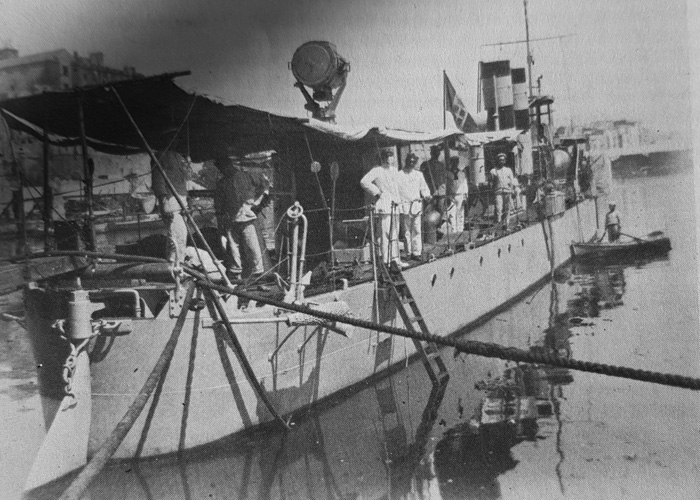
Stern of the Albatros (A Fracarolli coll. via conways)
As the First World War broke out, after the entry in to the war of italy, Perseo and Cigno received two 76 mm (3 in)/40 guns instead of their old 47 mm, and a single Breda 13.2 mm machine gun for AA defense, as well as two 450 mm torpedo tubes only, but more releoads. The Alcione series however as rearmed had one of the two 76 mm guns fitted on an anti-aircraft mount.
In September 1911 these vessels saw action during the Italo-Turkish War. The Pegaso class and Cigno shelled shore objectives in support of the Tripoli landings, in November, and made reconnaissances and patrols off the Dardanelles (A squadron of five, Spica, Perseo, Astore, Climene and Centauro). During WWI they were considered obsolescent and converted for some as fast minesweepers. Perseo collided with Astore on 6 February 1917, but it was the exploision of one of its torpedoes that sink her. Arpia struck the unreported wreck of the Neapolitan frigate Torquato Tasso from 1861, on 17 January 1918. The hull damage and flooding was too quick for the ship to be saved and she sank in shallow water, but later raised and repaired. She was back in action in July 1918. The remainder were discarded 1923-1927.

Pegaso profile

Cigno group profile
⚙ (*Pegaso) Cigno class specifications |
|
| Dimensions/Displacement | 50.35 x 5.3 x 1.77 m, 216.5(210*) tons st. |
| Propulsion/speed | 2 shafts VTE, 2 Thornycroft boilers 2,900 ihp, 25 knots |
| Range | 300–350 nmi (350–400 mi; 560–650 km) full speed |
| Armament | 2x 57mm, 1x 47mm guns, 3x 17.7-in TTs (450mm) |
| crew | 3 officers, 32-39 men |
 Orione class TBs (1906)
Orione class TBs (1906)
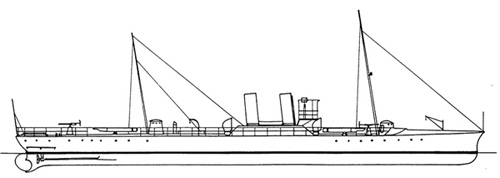
RN Orione profile
Orione, Orsa, Olimpia, Orfeo
These four Italian-built vessels were ordered in 1904, laid down in March 1905 at Odero’s Sestri Ponente, Genoa shipyard. They had two coal-fired Blechynden boilers for two sets of triple expansion steam engines (2,900 indicated horsepower/2,200 kW), for a design speed of 25 knots (46 km/h; 29 mph) and a range of 300 nautical miles (560 km; 350 mi) at 24 knots or 680 nautical miles at 18 knots. This was helped by an unusuallt clipper bow and their other caracteristic was two heavenly spaced funnels.
These four ships completed in February 1907-April 1908 reached 25.4 knots (47.0 km/h; 29.2 mph) in sea trials but proved less seaworthy than the Pegaso class. Olimpia and Orfeo helped the 1908 Messina earthquake relieaf effort, Orione collided with the other TB 128 S in April 1911. All four took part in the Italo-Turkish War, Libyan coast and Dodecanese, and formed the 1st Torpedo Boat Division in WWI, in Libyan waters, and between there and Italy. They had two 76 mm guns insalled in place of their 47 mm, and one tube removed. Orfeo collided with Calabria on 10 December 1917, repaired. All were discarded in 1920-1923.
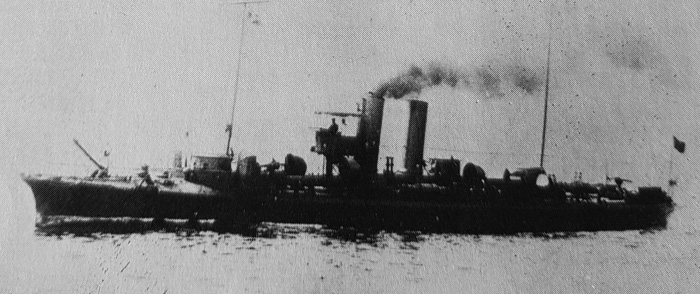
Conway’s profile of Orsa
⚙ Orione class specifications |
|
| Dimensions/Displacement | 52.6 x 6 x 1.5 m, 220 tons |
| Propulsion/speed | 2 VTE, 2 Blechynden boilers, 2900 shp, 25 kts, 300 nm/24 |
| Armament | 3x 47mm/40 3x 17.7-in (450mm) TTs |
 RN Gabbiano (1906)
RN Gabbiano (1906)

Profile of the Gabbiano
Gabbiano was built at the Regio Arsenale Shipyard, La Spezia, laid down on 2 April 1906, launched April 9, 1907 and completed on June 22, 1907, commissioned in September. She was Designed by the Naval Construction Directorate of the 1st Department, as prototype of a new class to replace the “S” class, with twin engines. 110S and 111S engines were used for RN Gabbiano. She was provided with two triple expansion, 2 stroke Schivhau steam engine, fed by two Normand small tubes boilers, driving two Sirio type three-blade propellers (1.80 m diameter), for a top speed of 22 knots. With 30 tons fuel aboard, autonoy was 1,508 miles at 8.5 knots, or 1,333 miles at 12 knots, 826 miles at 16 knots and 575 miles at 19.5 knots as reported on trials.
Armament included two 47 mm Hotchkiss M1901 cannons L/40 and 3 torpedo tubes Modello 1888s (356 mm), two forward fixed, one trainable aft, plus 14 mines (since 1909). The Crew of 32 comprised 2 officers and 30 non-commissioned officers, sub-chiefs and ratings. Her cost has been 457,165 lire, with a 20% saving compared to similar vessels. She had a galvanized steel hull, with 98 frames, divided into 11 watertight compartments. She also used planking o her flat deck aft (turtleback forward) ranging in thickness from 3 to 5 mm, with a bow and stern in forged steel. She was a good and robust vessel, but not followed in ater designs. Higher operating costs had her follow-up cancelled despite cost-effectiveness of reused engines, which were now technically outdated. Her armament was also lower than comparable vessels of the same tonnage.
Gabbiano on 22 August 1907 was assigned to the Torpedo Squadron of Civitavecchia. She took part in many squadrons exercises in Sicily and in the Tyrrhenian Sea, the great maneuvers of 1907-1908, and was overhauled in Venice, arriving on 20 October 1908. From February 1912 she was assigned to the Adriatic Lighthouse Inspection Service. From November as the Italo-Turkish ended, she became TS for Mechanical School cadets at Venice. On 23 March 1915 she was reassigned to the Hydrographic Service and on 24 May sent to Taranto for coastal surveillance. From 1917 she made to missions in Corfu, and in 1918 patrolled the Ionian Sea until the end of the war, followed by a disarmament in Taranto. She was stricken on May 15, 1921, BU 1921-22.
⚙ Gabbiano class specifications |
|
| Dimensions/Displacement | 49.62 x 5.92 x 1.38 m – 161.79 t standard 179.36 t FL |
| Propulsion/speed | Schichau TE engine, 2 Normand WT boilers 2.190 hp, 22 kts |
| Armament | 2x 47mm, 3x 15-in TTs (356mm) |
 1PN class (1911)
1PN class (1911)
1-12PN, 13-24OS, 25-32AS, 33-38PN:

PN** Type
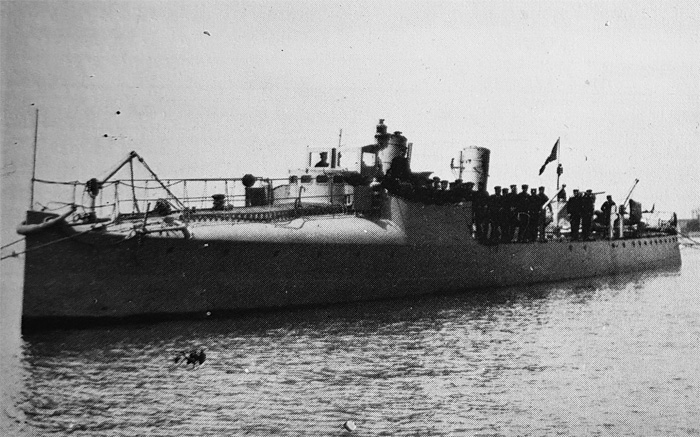
8PN (A. Fracaroli coll. via Conways)
The 1PN was the first prewar mass-built class of torpedo boats, thorty-three in all, built in four groups in separate yards: Pattison, Odero, Ansaldo and Pattison again, respectively. They were laid down from February 1910, based on the 1909 program and a redesigned standard, taking in part inspiration from RN Gabbiano, but smaller and cheaper. As a whole, they were considered rather successful, especially in the Adriactic Sea theatre when they were quite active. 31AS and 32AS were the only one experimentally equipped with three Parsons or two Bergmann steam turbines and same boilers as the others, but consumption was quite high as well as maintennace, with a rather lower reliability. They carried 16 tons of fuel oil for a raius of action of 175 nutical miles at 16 knots. Crew varied between 23 and 30 men.
The PN series were completed from June 1911 to December 1913. Some took part in the Italo-Turkish War and Balkan war of 1913. In 1915, some had their armament revised: 1PN to 4PN, 7PN, 8PN, 26AS to 30AS received all between 8 and 10 mines. 6PN received in 1916 a single 57mm/43 and a single 76mm/40 AA (76mm/30A and Breda 6.5mm/80 MG AA in 1914).
Torpedo boat 39RN was an experimental derivative, laid down at Arsenale di La Spezia on 7.1914, launched 12.8.1915 and completed in February 1916, to test a new composite powerplant, composed of 2 VDE, 1 steam turbine, and 2 super-heated steam boilers on triple-shaft. As a whole were considered rather successful, reaching 27 knots and allowing for more radius in the Adriactic. This combined machinery, combined with 27 tons of fuel oil reached 185 nm at max speed, and far more in normal conditions.
The 1PN and following saw action in the Adriatic, patrolling the sea and making coastal reconnaissance missions, almost all survived, stricken 1925-32, but 5PN was sunk 27.6.1915 by UB1 (Austrian U10) off Venice, and 17OS on 3.7.1915 from the accidental explosion of her own mine, off the Istrian coast. 36PN hit a mine and sank on 10.11.1918 near the Albanian coast.
⚙ 1PN class specifications |
|
| Dimensions/Displacement | 42.5 x 4.6 x 1.5 m, 120 tons/134-143 tons FL |
| Propulsion/speed | 2 VTE, 2 Thornycroft boilers, 3200 shp, 27 kts. |
| Armament | 1x Ansaldo 57mm/43 Modello 1883, 2x 17.7-in TTs (450 mm) |
Italian TB wartime classes
 40PN class (1916)
40PN class (1916)
40-45PN, 46-51OS, 52-57AS, 58-63OL, 64-69PN, 76-79CP (cancelled).
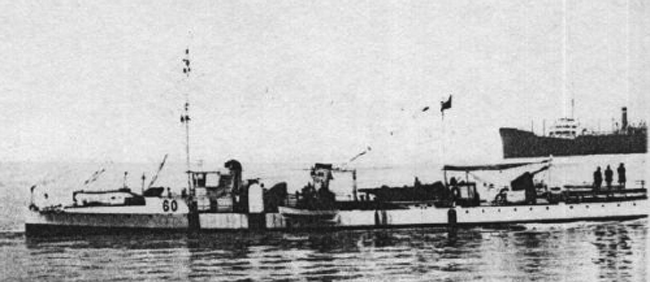
60OL at sea
The 30 boats became the main wartime torpedo-boat class of the Regia Marina. They were ordered in 1914, and built in 1915-18, the first commissioned in May 1916, the last in October 1918. They were built in Pattison, Odero, Ansaldo, Orlando like the previous vessels, with the addition of four more by CNR Palermo, which was cancelled. Unlike the previous boats however they were better armed and fitted to carry mines aft.
They were virtual repeats of the 1PN, but heavier, despite same hull dimensions. The same powerplant was repeated, with the same speed, and slightly lower endurance at 170 nm at 27 knots. Armament varied between series: 40-45PN, 53AS, 55-57AS, 61-63OL had two 76mm/30 A1914, and a twin 450mm TT, plus 10 mines. Other had in addition a 37mm/43 V1914 gun, while 64-69PN were delivered with two 76mm/30 A1914 guns and a single 6.5mm/80 Breda AA LMG. The rest was identical.
None was lost in action, notably due to their late entry into service, stricken in 1927-34.
⚙ 40PN class specifications |
|
| Dimensions/Displacement | 42.5 x 4.6 x 1.59 m, 129 tons/157-168 tons FL |
| Propulsion/speed | 2 VTE, 2 Thornycroft boilers, 2,700 shp, 27 kts. |
| Armament | 1x Ansaldo 75mm/30 A1914, 2x 17.7-in TTs (450 mm), 10 mines. |
 70OLT class (1917)
70OLT class (1917)
75OLT, 76OLT
Last wartime torpedo boats, 1st class, these larger vessels were originally ordered to Orlando, Livirno yard in 1915, laid down in June 1916 for the last two, and in November 1916, and planned in 1917 for 70-73 OLT. It happened that they were never laid down. 70OLT was left on its slip after little work was done and scrapped. They were officially cancelled in 1919.
74 and 75OLT were lainched in October 1917 and January 1918 respectively and completed in June and September 1918, seeing little service. The first was stricken in September 1934 and the other in November 1937. Also considered the III serie (which was Conway’s own classification), they were considered rather successful, and were equipped with turbines, but without much change in top speed and being far more expensive, less reliable. They had two 76 mm/30 A1914 guns and a trainable twin TT mount plus rails at the poop for 7 mines.
⚙ Serie III class specifications |
|
| Dimensions/Displacement | 44.5/45.7 x 4.6 x 1.78m, 168 tons/195 tons FL |
| Propulsion/speed | 2 Orlando Turbines, 2 Thornycroft boilers, 3500 shp, 27 kts. |
| Armament | 2x Ansaldo 76mm/30, 2x 17.7-in TTs (450 mm), 7 mines |
 Francesco Rismondo (1917)
Francesco Rismondo (1917)
Francesco Rismondo was the ex-TB11, ex-TB XI, an Austro-Hungarian boat which crew mutinied and on 5.10.1917, crossed the Adriatic, surrendered to the Italians. After the war she served until 1925 as beacons supplier.
It is of note that the Italians purchased British (Thornycroft) and Schichau (German) vessels, but never a French Normand design, which was the third great specialist of the time, and had credency given its exports and the scale of the French Torpedo fleet in 1906, as part of the “Jeune Ecole” credo.
Interwar egacy
The first postwar Italian TB designs were entirely new animals: Dictated by the Washington treaty which considered the below 600-ton category was not considered a threat, Italy found justification to start a massive production of Torpedo Boats, well-suited for the Confines of the Mediterranean. Only the Kriegsmarine took the same path in Europe, mostly for the Baltic. RN Albatros, built in 1933-34 in CNR Palermo, was a handsome, 25 knots 350/500 tons vessel, still with small 450 mm Torpedo Tubes but a modern armament, and a forecastle, the main difference compared to previous design. Rather small and classes at first as a sub-hunter, she served as a prototype for the following 600 tons Spica (1934-38), the twice heavier Pegaso (1936), and wartime Ciclone and Ariete class, in tonnage all way above 600 tonnes.
Sources/Read More
Gardiner, Gray, Randal, eds. (1984). Conway’s All the World’s Fighting Ships: 1906–1921.
AMM. Paolo M. Pollina. Le Torpediniere Italiane. Officio Storico della Marina Militare. Rome, 1964.
Jane’s Fighting Ships
The Naval Annual 1913
Chesneau and Kolesnik 1979, p. 359.
“Sezione Torpediniere: Sottosezione Torpediniere da costa: Classe Sirio”. Marina Militare.
Purnell’s Illustrated Encyclopedia of Modern Weapons and Warfare, p. 2138.
Beehler, William Henry (1913). The History of the Italian-Turkish War, Sept. 29, 1911 to Oct. 18, 1912.
Fraccaroli 1970, p. 78-80.
Beehler 1913, pp. 87–90.
arsmilitaris.org tessi sana, WWI italian naval Ops (it) (pdf)
On sulleormedeinostripadri.it
On arpa.veneto.it
cstn.it/notiziario/CSTN-38 (pdf)
On sanremostoria.it
Ariete on lavocedelmarinaio.com
Italian TBs on navypedia
museostorico.gdf.it – Trieste (It)
Torpedoes on betasom.it
www.marina.difesa.it – SaloneArmiSubacquee
grossetocontemporanea.it/22-culture-di-una-citta-di-frontiera-lo-stabilimento-whitehead-di-fiume-la-nascita-e-levoluzione-dellarma-siluro
regiamarina.net Torpedoes
Sirio-class_torpedo_boat
1914-18 online.net
Orione-class_torpedo_boat
Pegaso-class_torpedo_boat
ON on dreadnoughtproject.org
associazione-venus.it 1 (gallery)
associazione-venus.it 2
culturanavale.it
agenziabozzo.it
lavocedelmarinaio.com
List_of_ships_built_at_John_I._Thornycroft
gutenberg.org
RMG Images of Thornycroft Ariete





 Latest Facebook Entry -
Latest Facebook Entry -  X(Tweeter) Naval Encyclopedia's deck archive
X(Tweeter) Naval Encyclopedia's deck archive Instagram (@navalencyc)
Instagram (@navalencyc)





 French Navy
French Navy Royal Navy
Royal Navy Russian Navy
Russian Navy Armada Espanola
Armada Espanola Austrian Navy
Austrian Navy K.u.K. Kriegsmarine
K.u.K. Kriegsmarine Dansk Marine
Dansk Marine Nautiko Hellenon
Nautiko Hellenon Koninklije Marine 1870
Koninklije Marine 1870 Marinha do Brasil
Marinha do Brasil Osmanlı Donanması
Osmanlı Donanması Marina Do Peru
Marina Do Peru Marinha do Portugal
Marinha do Portugal Regia Marina 1870
Regia Marina 1870 Nihhon Kaigun 1870
Nihhon Kaigun 1870 Preußische Marine 1870
Preußische Marine 1870 Russkiy Flot 1870
Russkiy Flot 1870 Svenska marinen
Svenska marinen Søværnet
Søværnet Union Navy
Union Navy Confederate Navy
Confederate Navy Armada de Argentina
Armada de Argentina Imperial Chinese Navy
Imperial Chinese Navy Marinha do Portugal
Marinha do Portugal Mexico
Mexico Kaiserliche Marine
Kaiserliche Marine 1898 US Navy
1898 US Navy Sovietskiy Flot
Sovietskiy Flot Royal Canadian Navy
Royal Canadian Navy Royal Australian Navy
Royal Australian Navy RNZN Fleet
RNZN Fleet Chinese Navy 1937
Chinese Navy 1937 Kriegsmarine
Kriegsmarine Chilean Navy
Chilean Navy Danish Navy
Danish Navy Finnish Navy
Finnish Navy Hellenic Navy
Hellenic Navy Polish Navy
Polish Navy Romanian Navy
Romanian Navy Turkish Navy
Turkish Navy Royal Yugoslav Navy
Royal Yugoslav Navy Royal Thai Navy
Royal Thai Navy Minor Navies
Minor Navies Albania
Albania Austria
Austria Belgium
Belgium Columbia
Columbia Costa Rica
Costa Rica Cuba
Cuba Czechoslovakia
Czechoslovakia Dominican Republic
Dominican Republic Haiti
Haiti Hungary
Hungary Honduras
Honduras Estonia
Estonia Iceland
Iceland Eire
Eire Equador
Equador Iran
Iran Iraq
Iraq Latvia
Latvia Liberia
Liberia Lithuania
Lithuania Mandchukuo
Mandchukuo Morocco
Morocco Nicaragua
Nicaragua Persia
Persia San Salvador
San Salvador Sarawak
Sarawak Uruguay
Uruguay Venezuela
Venezuela Zanzibar
Zanzibar Warsaw Pact Navies
Warsaw Pact Navies Bulgaria
Bulgaria Hungary
Hungary

 Bundesmarine
Bundesmarine Dutch Navy
Dutch Navy Hellenic Navy
Hellenic Navy Marina Militare
Marina Militare Yugoslav Navy
Yugoslav Navy Chinese Navy
Chinese Navy Indian Navy
Indian Navy Indonesian Navy
Indonesian Navy JMSDF
JMSDF North Korean Navy
North Korean Navy Pakistani Navy
Pakistani Navy Philippines Navy
Philippines Navy ROKN
ROKN Rep. of Singapore Navy
Rep. of Singapore Navy Taiwanese Navy
Taiwanese Navy IDF Navy
IDF Navy Saudi Navy
Saudi Navy Royal New Zealand Navy
Royal New Zealand Navy Egyptian Navy
Egyptian Navy South African Navy
South African Navy






























 Ukrainian Navy
Ukrainian Navy dbodesign
dbodesign